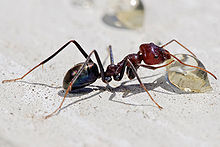Dolichoderinae
| Dolichoderinae | |
|---|---|
 |
|
| Iridomyrmex purpureus feeding on honey | |
| Scientific classification | |
| Kingdom: | Animalia |
| Phylum: | Arthropoda |
| Class: | Insecta |
| Order: | Hymenoptera |
| Family: | Formicidae |
| Subfamily: |
Dolichoderinae Forel, 1878 |
| Type genus | |
|
Dolichoderus Lund, 1831 |
|
| Diversity | |
| 48 genera | |
Dolichoderinae is a subfamily of ants, which includes species such as the Argentine ant (Linepithema humile), the erratic ant, the odorous house ant, and the cone ant. The subfamily presents a great diversity of species throughout the world, distributed in different biogeographic regions, from the Palearctic, Nearctic, Afrotropical region and Malaysia, to the Middle East, Australian, and Neotropical regions.
This subfamily is distinguished by having a single petiole (no post-petiole) and a slit-like orifice, from which chemical compounds are released, rather than the round acidopore encircled by hairs that typifies the family to which it belongs, Formicidae. Dolichoderine ants do not possess a sting, unlike ants in some other subfamilies, such as Ponerinae and Myrmicinae, instead relying on the chemical defensive compounds produced from the anal gland.
Of the compounds produced by dolichoderine ants, several terpenoids were identified including the previously unknown iridomyrmecin, isoiridomyrmecin, and iridodial. Such compounds are responsible for the smell given off by ants of this subfamily when crushed or disturbed.
...
Wikipedia
